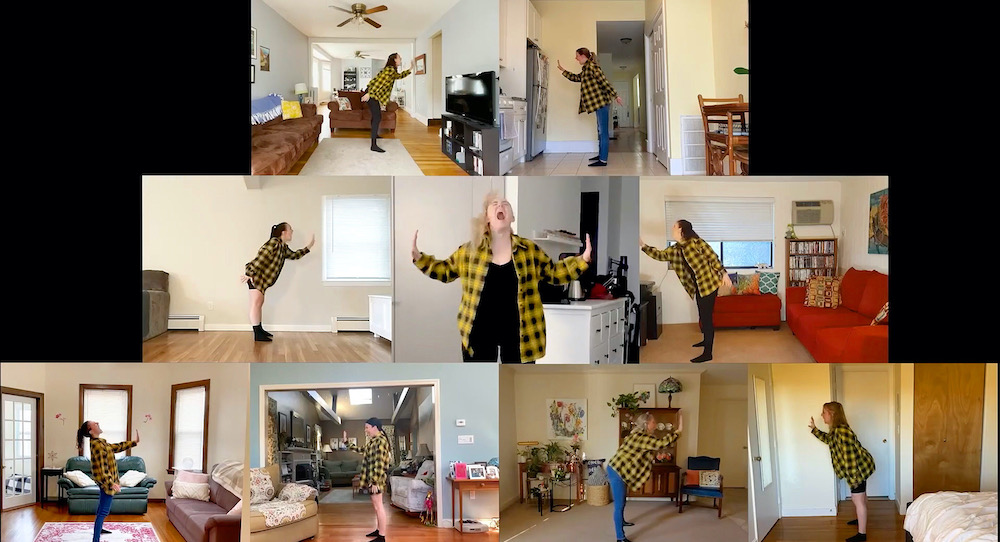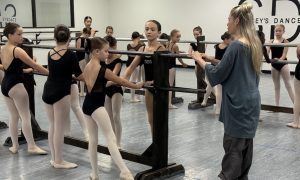April 16-May 10, 2021.
Accessible through the company’s website.
Moving together in the stage lights, feeling the energy of your castmates and the audience: rehearsing and performing virtually can’t replace that. Similarly, on the audience side, the feel in your bones of dance art happening right before you is in no way the same as watching a dance film from the comfort of your home. That’s what dancemakers are grappling with in the context of COVID. Yet, as we can expect from artists, they have in no way let these challenges stop them. They’ve adapted to make the best of the situation through learning more about the various possibilities that videography can bring to their work, and through that creating a new kind of dance magic.
OnStage Dance Company’s Season 20 film program demonstrates this perseverance and ingenuity with what filmed dance can be. Fresh concepts and enthusiastic, committed performances bring further life to the use of various film tools in different pieces. These are tools that create final products that, arguably, couldn’t ever really be created on a stage. Here are some of the pieces in the program that resonated with me the most, as well as demonstrated some of the broad possibilities within dance on film.
Mykala Marcelino’s Proud Mary, set to Tina Turner’s iconic song, is a lively tap piece. It’s nice to see tap, which can feel less appreciated than many other dance forms nowadays, open the show. The piece begins with a black and white filter and the dancers wearing grey costumes, along with the slower music in the classic song’s beginning. Then, as the song picks up energy and speed, the piece becomes a giant dance party. The dancers shed their grey jacket costumes to reveal red fringe dresses — ones that would make Ms. Turner proud!
The work offers big movement through space and through the body (such as almost thrash-like reaches and releases through the torso) for a tap piece — which serves its energy. Line and circle formations bring to mind the shape of a river and its continuity. Proud Mary keeps on burnin’ and yearnin’, after all.
Melissa DeFriesse’s What’s Up has memorable camera effects: fading in and out, Zoom squares intersecting with one another, building formations such as pyramids. It’s fascinating how choreographers and videographers are finding these ways to replicate in film what happens in a typical dance on a stage! The grunge costumes of flannel and black pay homage to the grunge era of the song.
The confidence and self-accepting attitude of grunge is also in the movement — with directly facing the camera and reaching big in a sustained quality. The dancers’ honest emotionality, such as in a moment of all opening their mouths as if screaming, also feels aligned with the song’s grunge era — as well as the one we’re currently in.
Nadya Karpova’s Fireflies has a heartwarming childlike quality. Dancers, reminiscing fairy-like creatures, move outdoors against backdrops of forests, lakes, and mountains. The gold in their costumes and their string light props reference fireflies’ pointed illumination. The movement alternates between ballet and jazz, perhaps playing to individual dancer’s strengths. They move carefree and easy, like beings that can fly wherever they please.
Interspersed with their dancing, shifting to and from them with a glittery Tinkerbell swipe, are two little boys reading a book together. Toward the end of the work they close the book, and with a tinkerbell swipe lights are at their feet and their faces light up. My heart bursts!
Throughout the work, close-ups vary up the visual picture. One shot of dancing feet is particularly compelling. I wonder if similar shots of more dancing feet — or even hands, arms, torsos could bring more of that effect and play at the childlike curiosity in the work (children focus both out and in, wherever they are called to focus to learn).
Nikki Haggan’s Independent is a hip-hop piece that means business, just like the “independent woman” speaker in the song. They wear black onstage together (with black masks and black scarves as headbands), against a black darkdrop. Movements are staccato but somehow also have a satisfying smoothness. They move with the energy of the speaker in the song, women with the strength to move through the world independently.
Jennifer Kuhnberg’s Walk (It Off) is a somber, memorable piece set entirely on dancers’ beds. Their expressions range from pained to determined, and the instrumental score supports those feelings. Camera shots of mainly dancers’ upper bodies, through fades and other editing tools, add further movement — even though the gesturing and movement in the shot offers plenty to enjoy. The dancers are alone in their own spaces, but seem united in a shared experience.
Marcelino’s &burn has a compelling theme of fire — demonstrated through candles in indoor portions, a flame in a campfire in outdoor portions, and a fire effect overlaid on screen towards the end. The dancers wear black costumes in the indoor sections and white costumes in the outdoors sections — both contrasting the deep reds and oranges of fire. Dancers move with the intensity of fire — yet also with the sinuous, serpentine quality of it lapping in a breeze.
The camera follows the dancers moving in canon and through formations at certain points, creating intriguing vantage points — a different approach than the fades and other videography techniques that other pieces use. The resulting effect demonstrates how a camera can also act as a dancer in a film dance work. These approaches are all valuable in their ways, and have different things to contribute to — more or less effectively — different works. Part of art making is making those creative choices, and many dancemakers are now learning — in real time — how to make a whole new set of such choices.
Catherine Shortliffe’s March March is to a song by The Chicks (formerly The Dixie Chicks) about rising up in protest. The piece opens with a split screen of alternating soloists dancing and beside them women standing with protest signs. Later, shots of dancers moving are overlaid on protest scenes. Intersecting shots make compelling formations without dancers being together, as in Whats Up earlier in the show.
Throughout, the dancers move with the conviction yet straightforwardness of marching in protest. They wear pedestrian clothing, reinforcing the shared belief in activist circles that if you’re with us, you’re welcome, no matter who you are — so come as you are. Indeed, the dancers come as they are in the piece.
Sandra O’Donnell’s Together, Apart is a light and easy ballet piece, one that’s simply pleasant to take in. It opens with shots of dancers on their computers, those focusing on their typing hands. A metronome sound brings to mind the passing of time and needing to stick to deadlines. One of the dancers texts the group of them, and then they’re warming up together. Shots focus on their feet pushing through tendus — an effect that’s beautiful in a simple way.
They then move together, even though they’re apart, to a lovely instrumental piece — the camera now showing all of their dancing bodies versus just their feet or hands. The metronome comes back at times, as if representing a nagging worry to finish dancing and get back to work. Instead, they individually lace up shoes and leap big outside — finding joy and freedom in their bodies and wide open outdoor spaces.
Chelsea Lepkowski and Hannah Perry’s Acapella is an enjoyable tap piece with only the sound of tapping as a score. The dancers tap outside on wooden boards, outside of a subway station. There’s a 1980s vibe through a mini boom box and costumes with neon yellow and fishnets — an intriguing aesthetic paired with the bright murals behind them (which also contributes to the piece’s urban feel). Walking on a quiet morning or late at night in a city, lightly singing to yourself or the sounds of your steps can be your own acapella accompaniment to your traveling, and there’s a certain beauty to that — one which this piece gets at.
The ending of the whole program offers each dancer a moment to move independently with their name featured, with matching OnStage Dance Co t-shirts — which feels almost like a private bow moment for each dancer. They take a joint bow at the very end, through more than forty Zoom screens, a wonderful moment making clear that the program is a true — and big — team effort. Through the challenges of COVID, OnStage Dance Company is not quite onstage, but they’re still dancing and finding new ways to create — with new tools, new approaches, new perspectives. The discovery can be the good part!
By Kathryn Boland of Dance Informa.















